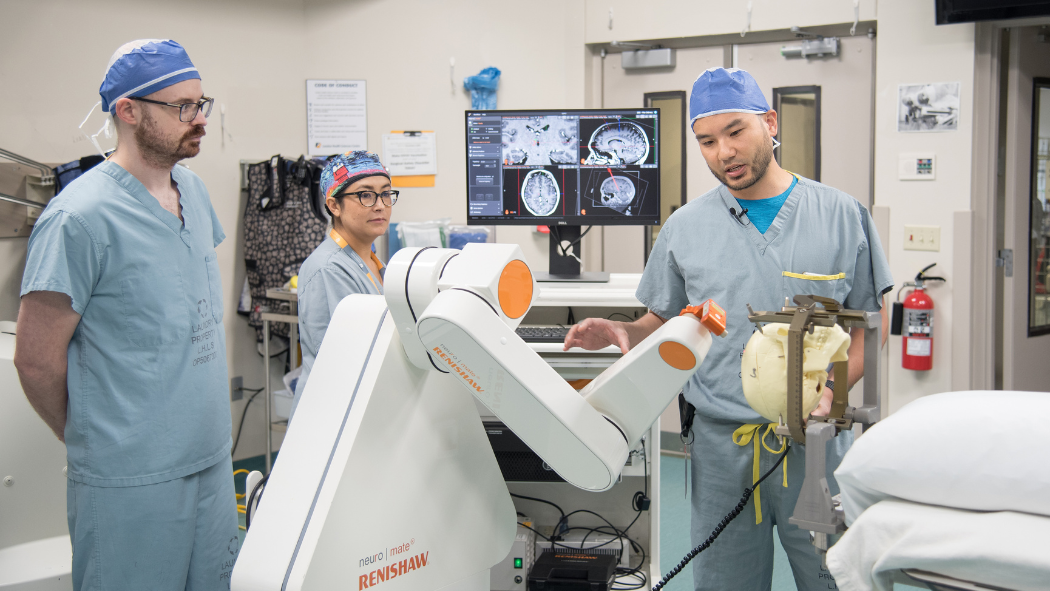The London Health Sciences Centre (LHSC) is celebrating a country first.

Earlier this year, the first robot-assisted deep brain stimulation surgery in Canada was completed at University Hospital.
The surgery helps treat seizures caused by epilepsy, one of the most common neurological disorders in the world as it affects roughly 300,000 Canadians.
According to health officials, deep brain stimulation survey involves “placing electrodes in the brain that are connected to a pacemaker which provides stimulation to alter brain activity enough to prevent or limit seizures.”
Dr. Jonathan Lau has successfully completed three surgeries using the robot since January. He said that using the Renishaw Neuromate robot to assist in the surgery helps with the accurate and safe placement of electrodes while simultaneously accessing difficult-to-reach areas of the brain.
“I didn’t think that I would necessarily be doing a first in Canada or implanting brain pacemakers. But I think the field is evolving rapidly right now, allowing us to offer these new treatments for patients that need it,” he said.
LHSC said that epilepsy is characterized by recurrent seizures, which are identified as “brief episodes of involuntary movement that may involve a part of the body or the entire body.” These episodes are also sometimes accompanied by loss of consciousness.

Get weekly health news
Lau said that the neurological disorder can sometimes be treated by removing the part of the brain where seizures originate. However, if it is in an area that is responsible for essential activity, such as logical thinking, removing the area is then ruled out as an option.
This is where the deep brain stimulation surgery comes in, according to Dr. David Steven, a neurosurgeon at University Hospital and chair of the Department of Clinical Neurological Sciences at the Schulich School of Medicine and Dentistry at Western University.
“It’s a treatment that’s available to patients who were traditionally not considered candidates for surgery,” he said. “By the time we see them, the seizures, or the fact that they might have a seizure, gets in the way of their everyday life and additional medications or changing medications rarely is successful.
“For some patients, this is an extremely effective treatment and reduces their seizures by a very significant amount,” Steven added.
The Neuromate was given as a donation to the London Health Sciences Foundation back in 2017 and was first used in robotic-assisted stereoelectroencephalography procedures — the mapping of epileptic seizure activity in the brain for patients who may not respond to medication or traditional treatment.
Lau told Global News that he and his team wanted to “localize” the procedure by increasing accessibility as well as frequency in terms of patient treatment.
“The fact that we can see these brain targets more clearly and target them more precisely and building also on the experience of the group helps to innovate and find new ways to help people with epilepsy,” he said.
Lau added that while a human can safely perform the surgery, a robot can remove some common mistakes and errors.
“It’s still a guide for us as it’s robot-assisted,” he said. “There’s still that aspect of human interaction combined with the surgical aspect that is still crucial to the procedure going off properly, but it really eliminates some of the cognitive load with doing parts of the operation.
“It’s also really nice to be able to offer something where patients can wake up the same evening, feeling the same, and then go home pretty much right away,” Lau added.
Cathy Vandersluis, president of University Hospital, highlighted that since opening its doors in 1972, the hospital has had “a long history of breaking ground in surgical techniques, including in neurosurgery.”
With the future sitting on the horizon, Lau said this surgery has the potential to carve the way for the treatment of other neurological disorders in the years to come.













Comments